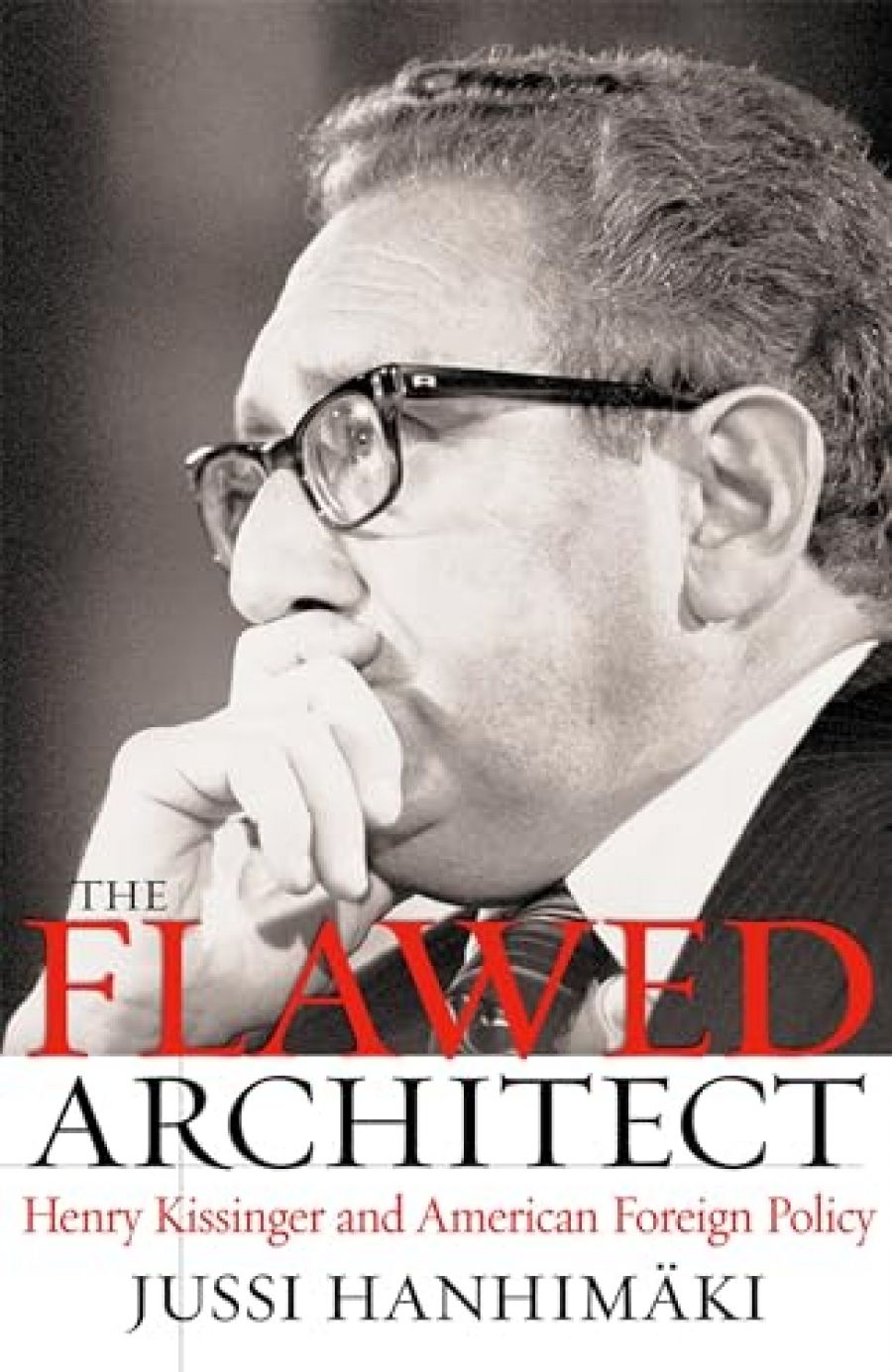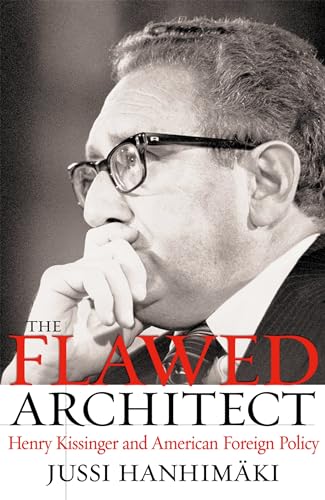
- Free Article: No
- Contents Category: Biography
- Review Article: Yes
- Article Title: ‘Super K’ Revisited
- Online Only: No
- Custom Highlight Text:
Henry Kissinger is one of the most fascinating, enigmatic, brilliant, paradoxical, and infuriating figures in recent US history. Born in Germany in 1923, he emigrated to the US with his family in 1938 and was naturalised in 1943. After army service and picking up a Harvard PhD, he became an academic there and an adviser to various think-tanks on global strategy and defence. He owed his introduction to government work, surprisingly, to Nelson Rockefeller, leader of the liberal wing of the Republican Party, but attained superstar status working for Rockefeller’s bête noire, Richard Milhous Nixon. He was Nixon’s Assistant for National Security Affairs 1969–75 and Secretary of State 1973–77, continuing under Gerald Ford after Nixon’s forced resignation over Watergate, in August 1974. He shared the 1973 Nobel Peace Prize with Le Duc Tho, who refused it for his efforts, premature as it turned out, to end the Vietnam War.
- Book 1 Title: The Flawed Architect
- Book 1 Subtitle: Henry Kissinger and American Foreign Policy
- Book 1 Biblio: Oxfprd University Press, $85 hb, 569 pp
- Book 1 Cover Small (400 x 600):

- Book 1 Cover (800 x 1200):

After 1977, Kissinger maintained his high profile as a consultant, writer, lecturer, and media personality. He published three long volumes of autobiography, and Diplomacy (1994). Presidents Ronald Reagan and George Bush Sr did not invite him back to government service. An invitation in 2002 from George W. Bush to conduct an enquiry into the September 11 terrorist attacks had to be declined due to conflicts of interest and media attacks.
I used to think that Peter Sellers’ character Dr Strangelove was based on Kissinger, and certainly the thick accent and mannerisms were similar, but Terry Southern’s film appeared in 1963 when Kissinger was a Harvard academic. (The Hungarian physicist and Cold Warrior Edward Teller was the likeliest candidate for Strangelove.)
Stanley Hoffmann, another Harvard Professor of International Relations, wrote that Kissinger had three great gifts that served him well.
One was an almost devilish psychological intuition, an instinct for grasping the hidden springs of character, of knowing what drives or dooms another person … His second gift is that of a man particularly attuned to the nuances of cultural difference … People who have been transplanted from one country to another … often develop this sense … Kissinger’s third gift is one that puts into practice his insights into personalities and cultures: it is the gift for the manipulation of power …
Jussi Hanhimäki, author of The Flawed Architect: Henry Kissinger and American foreign policy, is Professor of International History and Politics at the Graduate Institute of International Studies in Geneva and editor of the journal Cold War History. I reflected glumly that I had begun reading Henry Kissinger even before Professor Hanhimäki’s birth. Kissinger’s A World Restored: Castlereagh, Metternich and the restoration of peace 1812–22, the subject of his PhD, was published in 1957. It is an engrossing work, which Hanhimäki passes over too lightly. Europe had been convulsed by war between 1793 and 1815 – first the French Revolutionary War, then the wars associated with Napoleon. Kissinger identifies Castlereagh, Britain’s Foreign Secretary, and Metternich, Foreign Minister of the Habsburg Empire, as the most important figures who, even before Napoleon’s final defeat in 1815, began planning the balance of power in a postwar Europe.
The Congress of Vienna was essentially window-dressing. The important decisions were made in secret, by powerful figures, operating in a world of realpolitik, remote from what could even be remotely imagined as democratic or even open processes. The justification of the Congress system, and of its shadowy internal decision-making was that Europe enjoyed a century of peace (1815–1914), broken only by short, localised conflicts: the Crimean War; Bismarck’s three wars (against Denmark, Austria and France) to establish Prussian; then German hegemony; the wars of Italian unification; and some Balkan eruptions. However, the rigidity of the alliance system ultimately created the irresistible tensions that resulted in the carnage of World War I.
In his career as diplomat and policy maker, Kissinger had the joy of acting out his PhD thesis. Metternich was a hero, together with Richelieu and Bismarck, who operated ruthlessly and effectively before and after his chosen period. In each case, the force of personality and the ruthless logic of power were decisive in securing an outcome. Nixon was determined to run his own foreign policy, sidelining the State Department, not for the first or last time, and Kissinger was his willing accomplice. However, Nixon became mistrustful of Kissinger as their mutual dependence increased. Kissinger’s non-stop, secret shuttle diplomacy became the subject of international attention and speculation, which had not been Nixon’s intention, but he could not remove ‘Super K’ when Watergate was forcing the presidency into an increasingly paranoid bunker.
Kissinger was a master of ‘triangulation’ in diplomacy, exploiting the growing differences between the USSR and China. Sometimes the United States would go China’s way, for example in backing Pakistan in its war with India, then a Soviet client. Kissinger believed, wrongly, that Russia was directing North Vietnam’s war strategy and that pressure on Moscow would change Hanoi’s priorities. Kissinger’s greatest triumph was to initiate personal contact with the People’s Republic of China. He established good relations with Zhou Enlai in July 1971. Nixon made a follow-up visit in February 1972 and met Mao Zedong, although full diplomatic relations were not restored until Jimmy Carter’s presidency (1977-81).
Hanhimäki’s book has been overtaken by the Freedom of Information release in 2004 of tapes and documents from the Nixon White House. These confirm the accuracy of what Nixon himself called ‘the madman theory’, an attempt to generate enough fear to persuade Moscow and Beijing that he was about to use nuclear weapons in Vietnam and that they should press Hanoi for an early end to the war. In ‘Operation Giant Lance’, not mentioned in The Flawed Architect, nuclear armed B52 bombers were regularly flying near the Soviet Union’s airspace in 1969. Johnson’s strategy in Vietnam had emphasised predictability, a steady, inevitable escalation of military force. Nixon opted for uncertainty, to keep the enemy guessing, unable to predict how or where the next blow would land, if at all. Nixon, with Kissinger’s support, ordered saturation bombing of Cambodia and Laos, in a campaign that was kept secret from Congress and the American public, and went on for years. Its direct result was to create the opportunity for Pol Pot’s Khmer Rouge and his genocidal seizure of power.
Covert American support of the coup against Salvador Allende in Chile (September 1973), which resulted in two decades of authoritarian rule by Augusto Pinochet, is another dark page in Kissinger’s record. So was his (and Ford’s) endorsement of Indonesian President Suharto’s invasion of East Timor in 1975, apparently a last reliance on ‘the domino theory’, where Indonesia was seen as reliably anti-communist and East Timor as a potential Cuba.
Kissinger’s record came under sustained attack by Seymour Hersh in The Price of Power (1983) and Christopher Hitchens in The Trial of Henry Kissinger (2001). Hanhimäki agrees that Kissinger is guilty as charged, but puts in a plea for leniency. He concludes: ‘Kissinger’s actions were, perhaps, mere symptoms of a warped mentality that devalued human life and allowed policy makers to make [sic] numerous costly decisions in the name of national security and a global struggle against communism.’
The spirit of Kissinger is still abroad in Washington: not in the State Department, to be sure; he is not exactly a fundamentalist or an unreconstructed neocon. But the brutality of realpolitik and the pressure to make decisions on the run are major elements with Bush’s White House advisers, many of whom worked for Kissinger in an earlier life.


Comments powered by CComment